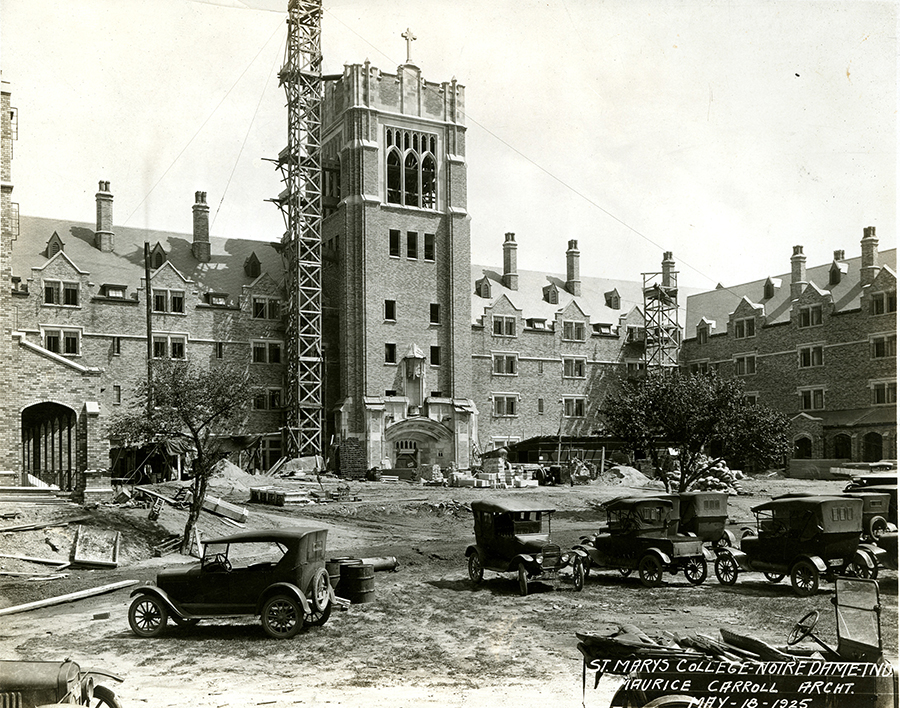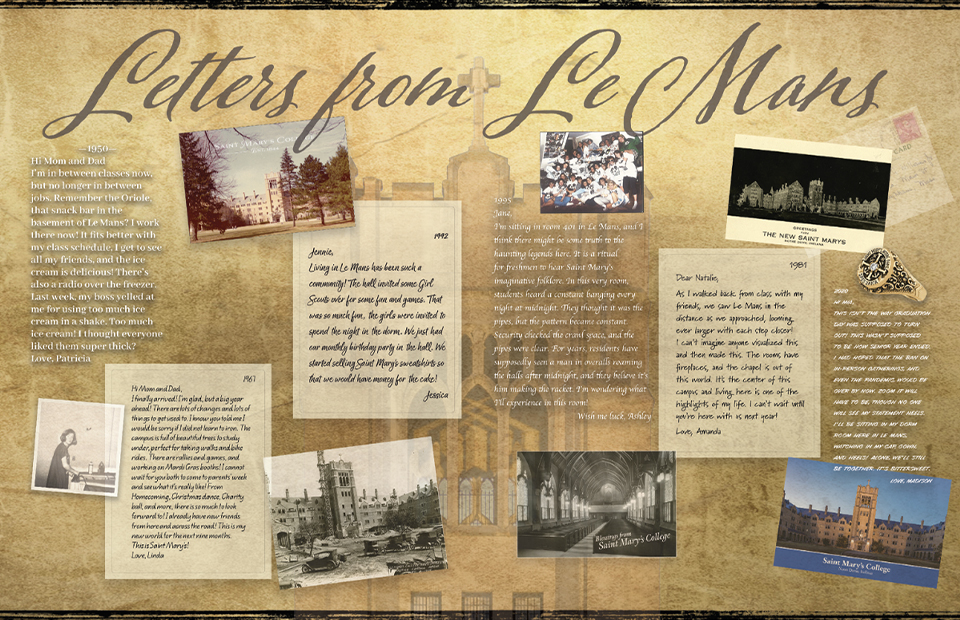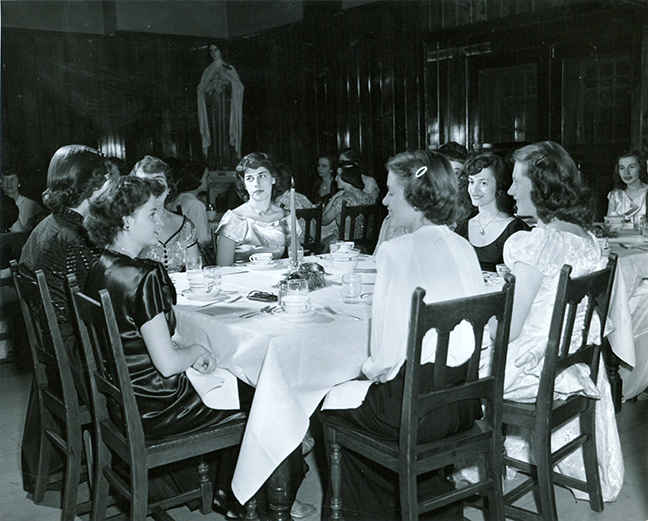A Centennial of Home
Le Mans Hall Celebrates 100th Anniversary


During a panel discussion at this summer’s Reunion about life in Le Mans Hall, former resident Christin Kloski ’15 shared a story about how she met one of her best friends. “I came back to my room and a girl was sleeping in my bed. I was really taken aback,” Kloski said. Kloski’s roommate whispered that the sleeping student was a nursing major who had classes in the science building in a few hours. She didn’t want to go back to her own room in Regina Hall.
“When she woke up, I asked her who she was,” Kloski remembered. “She became one of my best friends. Now I sleep in her daughter’s bed when I visit her. It’s a full wraparound of how special Le Mans is to me.”
This year, Le Mans Hall, the Tudor gothic centerpiece of Saint Mary’s College, turns 100 years old. Le Mans, often called “The Castle” by alumnae, has been home to thousands of women over the past century at a pivotal point in their lives. Time may separate them, but their experiences of spending four formative years there connects them across generations. Deep within the College archives are myriad stories that keep this brick behemoth pulsing with life.
Mother Pauline O’Neill, CSC, the first and longest-serving president of Saint Mary’s College, dreamed of a building dedicated strictly to the College at a time when the College’s buildings served dual purposes with the Sisters. O’Neill envisioned the building down to its name, choosing Le Mans Hall after the city in France where Father Basil Moreau founded the Sisters of the Holy Cross in 1841.
Stella Hamilton Stapleton, Class of 1892, was a friend of Mother Pauline. Stapleton donated $50,000 in 1916 to jumpstart the fundraiser. Her donation would be $1.5 million today. “I had the honor of giving the first $50,000 toward Mother Pauline’s dream of our magnificent new College building at Saint Mary’s,” Stapleton said in an Alumnae Association newsletter. Stapleton Lounge, where thIs summer’s Reunion panel discussion took place, is named in her honor.
In a May 1916 letter to Stapleton—found in the College archives and with the salutation “My dear Stella”—Mother Pauline wrote: “I am truly at a loss as to how to express my gratitude and appreciation of your generous gift. Really Stella, it seemed quite a while before my heart beat normally again, and were it not for your letter, I would’ve surely have convinced myself that it was all a dream.”
 By 1922, through a series of bazaars and other fundraising endeavors organized by Mother Pauline, the building fund for Le Mans had grown to $100,000. Mother Pauline even rewarded one such student endeavor that raised $13,000 with a dance that included an invitation to the men of Notre Dame.
By 1922, through a series of bazaars and other fundraising endeavors organized by Mother Pauline, the building fund for Le Mans had grown to $100,000. Mother Pauline even rewarded one such student endeavor that raised $13,000 with a dance that included an invitation to the men of Notre Dame.
At this point, Mother Pauline convinced the General Council that the time was now to build Le Mans if Saint Mary’s was to maintain its place as a leading Catholic women’s college. The project would cost $1.7 million—$31.3 million today—and the Holy Cross Sisters would hold the mortgage.
Margaret Carroll, a sophomore from the Class of 1925, contacted her brother Maurice Carroll, a 1919 graduate of University of Notre Dame’s architecture program. He won the bid to design Le Mans Hall—his first major project.
The Congregation of the Sisters of the Holy Cross broke ground for Le Mans on March 19,1924 and laid the cornerstone at Commencement in May 1924. Construction progressed throughout 1925. The completion of Le Mans Hall culminated in a Mass in Holy Ghost Chapel, now Holy Spirit Chapel, on April 24,1926, celebrating the fruition of Mother Pauline’s dream.
Some interesting facts about Le Mans at its initial dedication: it was 150,000 square feet and consisted of one million bricks, 17,000 feet of limestone trim—quarried from Bloomington, Indiana—and 188 tons of structural steel. The roof was slate, the stairways were concrete with a terrazzo finish. The total height of the building, including its tower was, and still is, 122 feet. Notes in the archives from 1939 declared Le Mans “absolutely fire proof.”
It wasn’t fire, it was memories of power outages that were recalled at this summer’s panel discussion, which featured reflections from alumnae from the classes of 1950 through 2020. Leticia McDonald Hart ’00 called Le Mans home all four years, and was a resident assistant (RA) her senior year. During power outages, RAs were assigned to watch doors until power was restored. “It was always the scariest two hours of my life because of all the ghost stories I’d heard,” Hart laughed.
An alumna in the audience recalled living with her roommates in a “quint,” a room that housed five students, at the top of Le Mans. “We had four hairdryers and a stereo going and the whole wing went dark,” she recalled. “We blew a fuse the first week we were here.”

In the College archives, a document from 1939 shows students how to conduct a proper tour of Le Mans Hall, which included the classroom spaces, the dorms, and the dining hall. Panelist Anne Reynolds Pyron ’50 lived in Le Mans for three years, where she and fellow seniors frequently dined with Saint Mary’s third president, Sister Madeleva Wolff, CSC. “It was a wonderful four years,” Pyron recalled.
Adaline Stefanac Cashore ’70, the unofficial historian on the Reunion panel, recalled some of her favorite spots in Le Mans. “There were large classrooms on the 2nd and 3rd floor. We could slide in with our trenchcoats on at eight o’clock in the morning.” she said.
“After 1941 and the building of the Centennial Library, that space in Le Mans became an art studio,” Cashore said, “After Moreau was built it became Queens Court.” Cashore also remembered “the Rectangle,” a place to play cards and smoke. “I would walk by that room, and it was a blue haze of smoke.”
Of course, technology, particularly the evolution of telephones, evoked plenty of stories among the multi-generation panel. Kathleen McAnaney Glaser ’65 remembered one phone for each hall. Students took messages and everyone could look at the call log. “Collective ooh!” she laughed.
Memories flowed as the panel discussion was opened to the audience. One alumna recalled: “It’s the spirit of community that makes Le Mans. We didn’t want to let a double ring go unheeded. We were there for each other.” She also remembered the massive bulletin board used to log messages. “If you received flowers or a package, it was on the bulletin board, and it made you feel special because everyone knew. Valentine’s Day was absurd.”
Cashore met her husband freshman year when he asked her to dance at a campus mixer with Notre Dame students. “He would walk over to the College because he could get through faster on a single ring rather than a double ring.” She noted that all Le Mans’ rooms got their own phones in 1967.
A double ring was an off-campus call, Hart recalled. “We had long curlicue cords, and if you didn’t want your roommate to know what you were talking about, you went out in the hallway to sit down and talk.”
For me, freshman year was really hard,” remembered Eileen Gallagher Loranger ’90. “It was a huge adjustment. For sophomore year, I was looking for a roommate, and I picked a friend from my classes who was also looking for a roommate. That changed everything. I found a cool new group to be with. It was a really special time for me and launched me in a new direction at Saint Mary’s.”
“I always remember when we wore wreaths and candles for Saint Lucia Day. The whole place was dark and it was just beautiful,” Glaser recalled as she thought of Stapleton Lounge during the holidays.
Reunion panel moderator and former Le Mans resident Shay Jolly Schneider ’05 was wistful as she contemplated her time here, especially when she visited with her niece. ”I can still smell the candles from the Holy Spirit Chapel and it takes me back. It takes me to a different place.”
November 18, 2025

